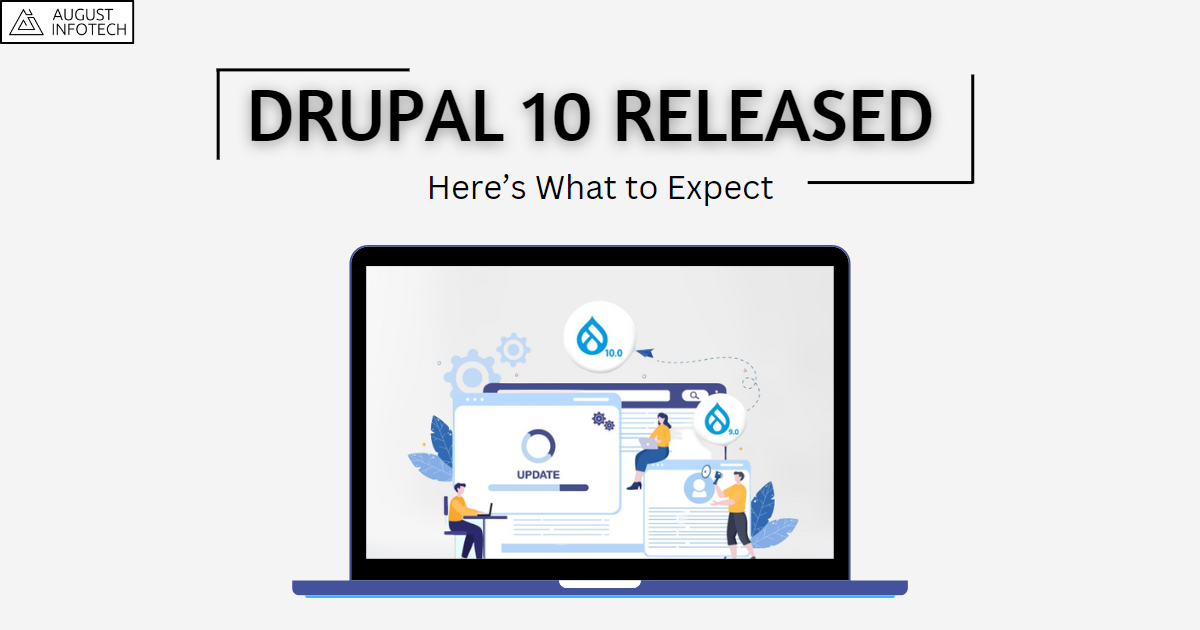Drupal, one of the world’s most popular content management systems, recently released its latest version, Drupal 10. This release includes several new features and improvements, making it a powerful tool for building and managing websites.
This blog post will provide a comprehensive overview of what you need to know and understand about the Drupal 10 features
so you can ensure your website/product is up-to-date and taking advantage of the latest technology. Let’s dive into Drupal 10 and see what it offers!
A Brief Introduction to Drupal
Drupal is a popular open-source content management system (CMS) used to build fantastic varieties of websites. It has gained popularity and fame due to its flexibility, scalability, and ability to handle significant traffic and content. Drupal has been with us for over two decades, and it’s used by businesses of all sizes, from small businesses to large enterprises and governments.
Drupal 10, the latest version, was released on December 14, 2022. With the release of Drupal 10, many new features and improvements can make creating websites more accessible than ever before.
What are the Newest Features in Drupal 10?
The most notable Drupal 10 features include:
- Take a backup of your website: The first and foremost thing before beginning the upgrade process is to back up your website to ensure that you can restore your website and its data to its current state if something goes wrong.
- Create a staging environment: After taking a backup of your website, create a staging environment if you don’t have one. This step will ensure everything will work after you update your website to Drupal 10.
- Upgrade to Drupal 10: Upgrade your website to Drupal 10 on the staging environment.
- Test your website: After upgrading to Drupal 10, test your website to ensure everything is working correctly. It will help you identify and detect any issues that need to be addressed and corrected before pushing to the production environment.
- Push to the production environment: Once ensured, push your website from staging to the production environment.
- Test again on the production environment: After pushing to the production, test your website one final time on the production.
Olivero Default Theme
The Drupal update includes the Olivero default theme, an upgraded theme that plays a vital role in determining the visuals of your website. This Olivero project has been in development for some time and is available in Drupal 9 development.
However, more capabilities are available now, making this theme more powerful and customizable. This updated design language allows users to easily and quickly create aesthetically pleasing websites and applications.
The Olivero Theme also includes enhanced image optimization and contrast adjustment tools. These tools will allow users to customize their websites and create more appealing designs for their target audience.
Symfony 6
Drupal 10 takes advantage of the latest technologies and trends in web development by utilizing Symfony 6.
Symfony 6 brings many new features, including improved routing, services, locales, multilingual support, and more. These features will be integrated into Drupal development services to make them even more powerful and efficient.
Decoupled menus
With the release of Drupal 10, updating your website’s menu will no longer be a task. You can make changes directly from the administration panel, which is a massive convenience for developers, especially those using Drupal as a headless CMS.
If your website on front-end frameworks like React or Angular, you’ll be able to make minor edits without needing a developer to do it for you. Drupal 10 also offers more options for simplifying the process of decoupling your website, making it even more user-friendly.
Automatic updates
Automatic updates finally took place in Drupal 10, the most awaited feature many website administrators eagerly awaited. With this Drupal version, security updates and Drupal’s core updates will take place automatically, making it easier for the user to keep their website up-to-date.
There are still some plans to expand this feature further, with support for minor updates and updates to other contributed modules. Keeping your website running will be even less hassle than before.
Claro Administration Theme
How you interact and use your CMS is incredibly important, and Drupal has made some significant upgrades in its latest version to ensure that the experience is as good as it can be. The Drupal community has developed a new theme called Claro to improve the administrative experience.
Claro gives Drupal’s editorial UI a modern and advanced look while preserving the core of Drupal CMS to help experienced users streamline their processes. Claro has now become the default admin theme and will receive updates bundled with Drupal core releases, ensuring users enjoy a better and more efficient experience while using Drupal 10.
CKEditor 5
Another prominent feature of the latest release is the inclusion of CKEditor 5. It is a popular text editor rebuilt to take advantage of the latest advancements in JavaScript. This text editor makes creating web pages much more accessible by providing an intuitive interface, improved accessibility options, and numerous plugins.
It is the enhancements to copying and directly pasting from Word Documents or Google Docs into the content editor. It’ll take away markup replica-pasted from the one’s packages.
Removed Deprecated Code
The latest Drupal version is taking steps to ensure the best user experience. It removes any outdated or unnecessary code from the core system, including retiring older code that you may not need with the introduction of new or improved code.
However, it’s important to note this process is gradual because removing specific code could cause issues with any customizations or additional modules a website may have. Instead, the code should be marked as “deprecated” and removed during Drupal’s next update, giving developers ample time to update their code and ensure compatibility with Drupal 10.
With these features and updates and many more to explore, Drupal 10 will surely ease the developers and users.
When is the Right Time to Upgrade to Drupal 10?
Depending on the version of Drupal you are currently using, you may be able to upgrade now or may need to wait for a later version.
Here is a breakdown of when to upgrade for each version:
Drupal 7
If your website is operating on Drupal 7, upgrading it to a higher or latest version is urgently required. You may need more security, automation, and technically advanced features when relying on Drupal 7.
Moreover, an upgraded system will improve performance and trustworthiness if your business relies heavily on its online presence and has a good customer base. It can enhance your customer experience as well as provide more scalability options.
Drupal 8
If your website runs on Drupal 8, it might need more features of assistance and a vast theme library. The key benefits of upgrading from Drupal 8 to Drupal 10 include the following:
- Improved access control capabilities.
- Better support for media assets.
- Enhanced content language support.
- More flexibility for managing views.
Drupal 9
Many modules of versions 9 and 10 will easily transit when upgraded without issue. Additionally, upgrading to the 10th version from the 9th offers increased performance benefits due to enhancements in caching, link generation, and response time optimization.
How to Upgrade from an Earlier Version of Drupal?
Suppose you’re currently using an older version of Drupal, whether 7 or 9; you’ll need to upgrade to version 10 to take advantage of its new features. Here are a few tips & guidelines to help you through the process:
Backup your website:
The first and foremost thing before beginning the upgrade process is to back up your website to ensure that you can restore your website and its data to its current state if something goes wrong.
Test your website:
After taking a complete website backup, test it to ensure everything is working correctly. It will help you identify and detect any issues that need to be addressed and corrected before you begin the upgrade process.
Consult with a Drupal expert:
Upgrading to a new version of Drupal can be a complex process and may require the need of experts, so it’s a good idea to consult with a drupal web development company to ensure everything goes professionally. Experts at August Infotech will help you with everything that provides seamless upgradation or even migration from any other CMS.
An experienced and knowledgeable team from a white-label web development company can help your website update efficiently. Don’t hesitate to contact August Infotech’s experts.
The Bottom Line
All in all, Drupal 10 is a significant release that offers many advanced features and improvements over previous versions. Whether you’re a developer, a content creator or a website owner, Drupal 10 has something to offer. It’s a powerful tool for building and managing websites, and it’s worth checking out.
Suppose you are interested in upgrading your website to Drupal 10. In that case, it’s important to note that expert help from an offshore development company will ensure you’re going accurately towards upgradation or migration. Our experts at August Infotech will readily help you serve with their expertise and knowledge of Drupal.
Get a free consultation for your website upgrade today with us!






